Copyright © HT Digital Streams Limited All rights reserved. Reshma Kapadia, Barrons 2 min read 19 Oct 2025, 17:53 IST Analysts are watching whether China sticks to a target of 4.5% or 5% or moves away from giving one at all. Summary The plenum convenes the party’s central committee to express its medium-term economic, technological and political blueprint. When the Chinese Communist Party gathers for its biggest annual political meeting this week, it is widely expected to unveil a five-year economic plan that doubles down on domestic innovation, security and stability as its rivalry with the US heats up. It is less clear whether Beijing will offer tangible steps to spur domestic spending and revive the economy, which remains stuck in a rut and teetering on deflation due to aggressive spending in areas such as electric vehicles and solar power. The plenum, set for October 20 to October 23, brings together the party’s central committee to outline its medium-term economic, technological and political blueprint. Many analysts expect policymakers to build on the Made In China 2025 plan unveiled a decade ago, which spurred aggressive investment in areas including artificial intelligence, robotics and semiconductors that are now at the center of the geopolitical rivalry with the US. The five-year plan will be formally approved in March when the National People’s Congress meets. This is expected to be a continuation of recent efforts with Beijing, which is likely to expand the sectors it hopes to prioritize – a signal to investors looking to invest with the government. “The previous five-year plan promoted Chinese emerging technology dominance; the new one will consolidate it,” says Rory Green of TS Lombard. That consolidation will fuel what many describe as a second China shock, hitting advanced manufacturing and increasing competition for a host of global companies in new areas. Green thinks quantum and supercomputing, semiconductor design and manufacturing tools, and many AI segments will be in focus. Beijing is likely to emphasize domestic procurement as it seeks to become less dependent on the US and others, particularly for the semiconductor supply chain. Investors will want Beijing to take a bolder stance to revive its economy, which is still sputtering amid a more than four-year slump in the property market and battered business and consumer confidence. They will see if policymakers go beyond talking about consumption to offer a viable plan to convince Chinese households to spend more. Kristalina Georgieva, managing director of the International Monetary Fund, said Thursday that China faces a fork in the road: Continuation of a growth model dependent on exports or reorientation toward domestic consumption. To do the latter, it must firmly resolve difficulties in the real estate sector and increase social safety nets. Instead of investing in industrial policy and spending 4% of GDP to support industries, Georgieva called on China to redirect that money into safety nets so that Chinese households don’t feel they have to save as much. “Anything that can boost the development of the consumption economy in the medium term is positive for investors,” said Kelvin Lam, senior China+ economist for Pantheon Macroeconomics. While China may not announce its target growth rate until March, analysts are watching to see if China sticks to a 4.5% or 5% target or moves away from giving one at all. One potential negative for investors: “If there is a strong focus on high-quality growth versus high-speed growth or an emphasis on debt control or deleveraging, that will be a negative,” said Michael Hirson, head of China research at 22V Research. Get all the Business News, Market News, Breaking News Events and Latest News Updates on Live Mint. Download the Mint News app to get daily market updates. more topics #china Read next story
China’s new 5-year plan comes as US rivalry heats up. Watch for these signals.
